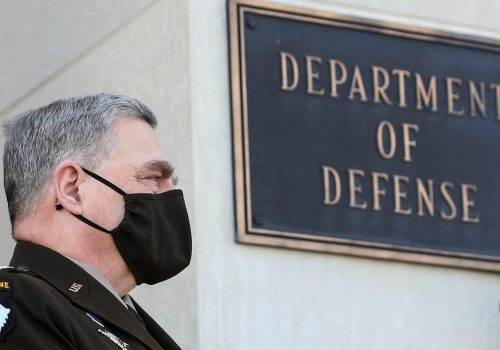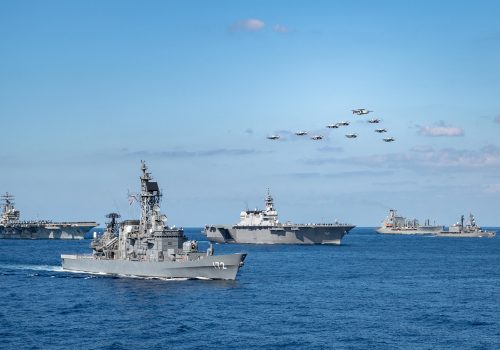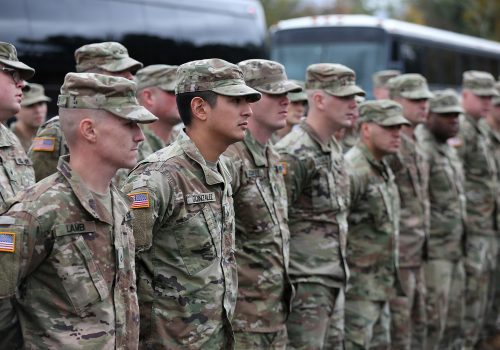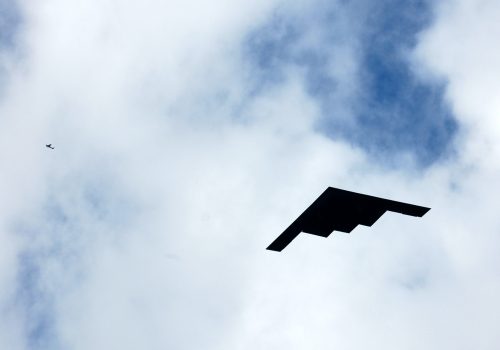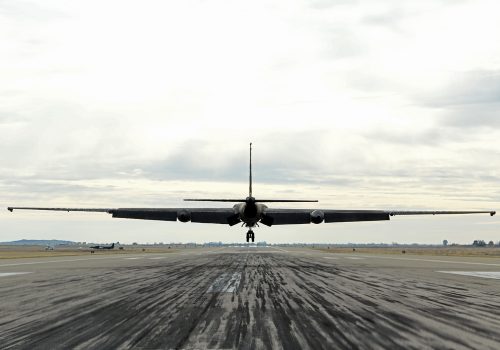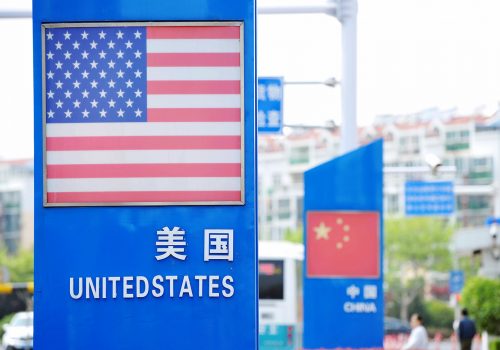How should the next National Defense Strategy balance terrorism, rogue regimes, and great-power competition?

In our expert question-and-answer installments, three featured experts answer five questions on a major theme for the next NDS.
During the Trump administration, the focus and strategy of US defense policy shifted from countering terrorism to gearing up for challenges from near-peer adversaries. Now, ahead of developing the next US National Defense Strategy (NDS), the Biden administration has ordered a review of defense strategy toward China and US force posture abroad. In this initial round of questions, our experts explore how the United States can tackle terrorism, address the advances of rogue regimes, and establish a balance between competition and cooperation with other global powers.
1. The 2017 National Security Strategy (NSS) and 2018 NDS largely revolved around five US adversaries—Russia, China, North Korea, Iran, and terrorist networks. Will these adversaries remain the same for the United States in the next decade? How will the United States balance its focus on rogue regimes, terrorism, and great-power competition?
Markus Garlauskas, senior fellow at the Scowcroft Center for Strategy and Security’s Asia Security Initiative: “These primary adversaries will almost certainly remain, but the challenges posed by them individually and collectively will evolve and possibly worsen. Russia’s high-end military capabilities, along with its willingness and ability to operate in the ‘gray zone,’ are likely to continue growing. China and North Korea will become increasingly strategic challengers as China continues to shield North Korea from the full consequences of its pursuit of more advanced nuclear and missile capabilities—and as the Korean peninsula becomes an increasingly key venue of US-China strategic competition. Iran, meanwhile, seems likely to either assert an increasingly influential role in its region or overextend itself while facing pushback from the Gulf states and Israel. Meanwhile, the fundamental question remains whether terrorist networks will remain primarily an overseas security threat to US interests or whether some combination of foreign and domestic terrorism will lead to a new mass-casualty attack in the United States.”
Kirsten Fontenrose, director of the Scowcroft Middle East Security Initiative: “During a decade that has opened with a pressing effort to recover from COVID-19 and its accompanying economic downturn, the United States cannot apply the necessary resources to countering the multifarious nefarious activities of rogue regimes and reimagined terrorist organizations while mounting global containment efforts aimed at Russia and China. The United States has acted in contradiction of the advice of transatlantic partners in dealing with Iran and has at times increased tension with China in dealing with North Korea. In order to reduce the burden posed on its defense sector, the United States should seek to minimize the resources that must be devoted to countering rogue regimes. To do so, it should focus on response mechanisms that do not require producing expensive materiel and can allow for a reduction in forward-deployed personnel focused on these regimes. These mechanisms may include strategic litigation, pacts of non-aggression, international diplomacy to redirect rogue-regime goals, etc.”
Mathew Burrows, director of the Scowcroft Center for Strategy and Security’s Foresight, Strategy, and Risks Initiative: “The United States no longer has unlimited means to counter a plethora of adversaries. Washington has only sporadically tried to reconceive the nature of its relationships with its adversaries. Still seeing itself as the unipolar power, it has also been reluctant to use the full panoply of its tools to negotiate, deter, and identify acceptable compromises.”
“Dealing diplomatically with some adversaries like ISIS and al-Qaeda is likely to prove fruitless. Any military solution must be coupled with encouraging countries in the greater Middle East to deal with the root causes of terrorism and insurgencies.”
“Why should we consider China an adversary? It owns $1.1 trillion of US debt and we are each other’s most important trading partner. A war would be devastating to both economies. We should find ways to put a floor under the competition and expand areas of cooperation.”
“Throwing Russia and China together is illogical and counters our long-term interests. A comprehensive US-Russia reset may not be possible, but the United States and Russia have mutual interests such as arms control. Keeping the door open should be a priority to avoid a growing Russia-China alliance.”
“In summary, the objective should be for the United States not to have adversaries. More effort needs to be made to avoid conflictual relationships. For that reason, the United States needs to develop its diplomatic, economic, and other tools, and not rely solely on the military option.”
2. What should be the United States’ goal in great-power competition and does that goal differ for China vs. Russia?
Garlauskas: “Great-power competition is fundamentally a more ambitious program for China as China is willing and able to compete with the United States on a more global basis, seeking to eventually establish hegemony in East Asia and at least parity with the United States on a global level. Meanwhile, Russia’s ambitions for such competition seem more modest, though more risk-acceptant, if only because its economic and cultural power is far less able to underwrite such competition.”
Burrows: “I’m not sure ‘goal’ is the right term. Certainly, there is growing competition, especially between the United States and China plus Russia. However, the strategic question is whether we should ramp up the competition despite the costs to the United States. What does it mean to win a competition? Historically, the goals the United States have set out are security, prosperity, and freedom. Ramping up competition to the point that conflict ensues would go against at least two of those historic objectives of security and prosperity. China will soon be the largest economic power in the world and a key driver along with the United States and Europe of global growth. Competition in a liberal sense—free trade, open markets, etc.—can be a good thing for boosting trade. Many in the US national-security community see the economic competition in mercantilist terms the way former King of France Louis XIV did with his European neighbors: What is good for my enemy is bad for me. The national-security community is fast slipping back into a zero-sum mentality.”
“China needs to open up more of its markets to US and Western investments, stop its practice of heavily subsidizing state-operated enterprises, and end intellectual-property theft and forced technology transfer. This will require engaging with China and working with allies on a strategy for confronting China in the World Trade Organization. The United States must get back on a path of ending tariffs on Chinese goods and engaging in regional trade pacts. Not pursuing the Trans-Pacific Partnership was a strategic loss. We are not part of any regional trade pact in Asia. A world that is poorer is not one that increases security for the United States. Such a world is likely to have more conflicts. Keeping options open to engage Russia is key.”
3. Is the United States already engaged in a new “Cold War” with China? If so, what are the implications of a new “Cold War” for crisis management, defense planning, and other threats and priorities?
Garlauskas: “A ‘Cold War’ is not a perfect term for what we face with China, but it may be the best one available that resonates with modern America. Unfortunately, China enjoys greater ‘soft power’ and economic potential than the Soviet Union did, even if it cannot match the relative might of the Soviet military at its height and is not as openly combative. The implications are vast and sweeping. Inevitably, the need to address the challenge from China will overshadow other national-security priorities to some extent. It will be particularly significant for issues relating to North Korea, because we cannot consider North Korea and China as separate security challenges. North Korea exploits Chinese protection as it escalates and defies the international community. Meanwhile, China has brazenly supported North Korea and strongly asserted its interests on the Korean peninsula, while seeking to both bully and entice South Korea away from supporting US positions and actions.”
Burrows: “Only in the minds of the military-industrial complex has the United States fallen into a ‘Cold War’ with China. For US business and finance, the goal is still to open up the Chinese market to more Western trade and investment, stemming deplorable Chinese practices such as forced technology transfers by Western firms doing business in China. China and the rest of Asia remain a growing market that US multinational corporations need to invest in if they are to grow themselves.”
“We have become the magnet for the world’s talent because of our open doors. US universities and tech innovation have benefitted enormously. Closing doors to China and other countries allied with it would undermine the very thing—innovation—that can spur economic growth for us.”
“Moreover, it’s unlikely our allies and partners would follow us into a Cold War. Germany exports as many, if not more, cars to China than to the United States. Other European allies are depending on investment from China to help with their economic recovery. Asian allies are even more dependent on China for their prosperity and would resent any US pressure on them to choose the United States over China. By initiating a Cold War, we risk isolating ourselves.”
Seizing the advantage: The next US National Defense Strategy
4. When thinking about Iran and North Korea, what tools can the United States leverage to pressure and limit rogue regimes’ weapons of mass destruction (WMD) programs?
Garlauskas: “It is important to draw a fundamental distinction between Iran and North Korea in this regard. As national-security problems, they bear small resemblance to each other. Iran has never tested a nuclear device or true intercontinental ballistic missile (ICBM) and even only recently alluded to ICBMs, while North Korea has repeatedly tested nuclear devices and ICBMs of increasing capability.”
“Iran is interconnected economically in its region and globally, while North Korea is isolated. Iran’s ideology, [state] religion, and funding of proxies allow it to exert regional and global influence and pose threats in a way that North Korea cannot. Meanwhile China’s close economic and geographic connection to North Korea enables and strongly motivates Beijing to shield North Korea, whereas Iran lacks the same level of protection.”
“As a result, though sanctions are the policy tool of choice, they have a far greater potential to contain the more nascent programs in Iran than in North Korea. Strong positive incentives are probably necessary as well in both cases—even more so for North Korea. If this amounts to ‘bribing’ rogue states not to further develop WMD, particularly nuclear weapons, this is a price that is probably ultimately worth paying—even if it may be distasteful to reward such regimes. This approach must be sharply different than the failed ‘appeasement’ of the 1930s, in that it must be clear-eyed about the nature of these regimes and robustly counter their tendencies for threats, coercion, and adventurism. Such an approach must therefore be backed by stronger deterrence and containment approaches in concert with US allies, as well as by efforts to fundamentally change the domestic and international dynamics that enable and drive these states to develop WMD.”
Fontenrose: “The premise here may not be sufficiently thorough for the NDS. While the nuclear programs of these regimes were the paramount concern of this decade, both regimes pursue additional nefarious programs that pose immediate threats.”
“North Korea’s chemical weapons are visually undifferentiated from conventional weapons and are stored alongside them in bunkers across the country. Should the United States be in a position to put forces on the ground in North Korea, this stockpile will place US troops in immediate physical danger.”
“Iran’s proxy groups have contributed significantly to the near-collapse of four nations in the Middle East, and Iran’s leaders state clearly that the use of such groups remains a pillar of its foreign policy. Both regimes engage in disinformation and cyberwarfare to hamper US objectives. A new NDS should think about disrupting these near- to mid-term threats as well as the long-term threat posed by WMD.”
“There are several tools the United States can use to place pressure on and limit the WMD programs of rogue regimes (which may include additional countries by the end of a new decade):
- Strategic litigation: The United States should leverage international human-rights and counterterrorism laws to bring cases against individual decision-makers in rogue regimes.
- End the deterrence justification with pacts of non-aggression: To remove the justification for the deterrence function of its nuclear program, Iran should be incentivized to sign a pact of mutual non-aggression with Saudi Arabia and the United Arab Emirates (UAE) that dictates no first strike; the pact should be made to include Israel via its Abraham Accords agreement with the UAE.
- Cyber disruption of nuclear facilities: US cyber activity continues to be the most effective tool against Iranian nuclear ramp-up.
- Snapback as a forcing function: The United States should insist that a return to the Joint Comprehensive Plan of Action (JCPOA) include a snapback to sanctions if Iran does not meet parameters in a specified period of time.”
Burrows: “North Korea and Iran are harder targets. Partly due to US threats of regime change against both countries, the two countries are determined to develop nuclear weapons as an insurance policy against US attacks. The initial success of the JCPOA in including Iran’s neighbors to influence Tehran (before the Trump administration took the United States out of it), is a template for stemming weapons development and making the Iranian regime think twice. Like we did for the JCPOA, we should be working again with North Korea’s neighbors, including China, to deter it from further nuclear-weapons development and proliferation. Besides broadening US efforts to include other partners, Washington also needs to think in terms of positive incentives and not just punishing with sanctions. We probably need to lower our expectations; post-Libya and post-Crimea, it will be hard to get any nuclear-capable countries to give weapons up. We may be able to induce a stop to further development if we are prepared to offer big economic and political incentives.”
5. Should the United States expand the concept of “national defense” to include emerging asymmetric threats typically nested under “national security” such as disinformation, political warfare, cyberattacks, and bioweapons (as well as hybrids of them)?
Garlauskas: “Political sensitivities, historical precedent, and legalities hamper such an approach in the United States, even though it is common elsewhere and would be wise. Though best addressed comprehensively within an NSS from a legal and practical basis, an NDS must also tackle them. Defense organizations already have clear roles to combat overseas disinformation, political warfare, cyber threats, and bioweapons—these can easily cross borders into the United States.”
Fontenrose: “The decision on where to place them should be based on:
- where the primary threat emanates, depending on whether it is foreign or domestic. If domestic, the topic must be included in the NSS versus the NDS.
- how urgent the threat is and where tools to respond to the threat sit. If the threat is immediately urgent and requires response within the first year of the administration, and if funds and capabilities currently available fall within the US Department of Defense (DoD) or parts of the Intelligence Community (IC), place the topic in the NDS. If the threat is long-term but not immediately critical, it is possible to legislate and appropriate, in order to enable other parts of government to take responsibility when preferred.
- which agency holds the relevant authorities. If the agency of government with legal clearance to act on the threat resides within DoD or parts of the IC, place the topic in the NDS, since debating and creating new authorities is a long and political process and will delay action indeterminably.”
Burrows: “The problem in labeling every threat a national-defense concern or even a national-security issue is that it leads US administrations to think first about military solutions, ignoring other tools inside and outside government for dealing with the problem. Disinformation, for example, comes in many forms and there is as much produced domestically by bad actors as manufactured by Russia, China, or Iran.”
“Europeans are experimenting with requiring tech companies to police their platforms for hate speech, the way media companies are forced to by their licensing agreements. Working with the tech companies here to remove disinformation is critical. Certainly intelligence agencies should be monitoring ways that Iran, China, Russia, and others seek to influence social media as well as working with tech firms to eliminate it.”
Ultimately, disinformation—like cyberattacks, bioweapons, and other big challenges—is a bigger issue than the military or even the whole of government can tackle. The national defense community needs to think more broadly, including by developing true partnerships with the private sector, to deal with hybrid threats. Private-sector actors, for example, complain that the intelligence government provides them is skimpy and incomplete, making it hard for them to counter threats. A solution for impediments to info-sharing needs to be found if we are to see a more comprehensive and strategic response to hybrid threats.”
Further reading
Image: US President Joe Biden delivers remarks to Department of Defense, at the Pentagon in Arlington, Virginia, USA, 10 February 2021. via Reuters
